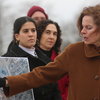GPL proposes $4.4M budget, under tax cap, expanding staff training
GUILDERLAND — Following the isolation of the pandemic, library patrons are back in full force.
“We are up above pre-pandemic levels now and I would attribute that to our building,” said Nathaniel Heyer, the library’s interim director.
On May 21, voters will decide on a $4.4 million spending plan, up from $4.3 million this year.
The levy is up 2.4 percent from this year, to $4,378,179, which is under the state-set tax cap so just a simple majority is needed to pass the spending plan. The Guilderland Public Library has never suffered a budget defeat.
The lion’s share of the district is in Guilderland where residents will pay $1.02 per $1,000 of assessed value. Parts of three other towns are also in the district: The Bethlehem rate is $1.15 per $1,000; the New Scotland rate is $1.17; and the rate in Knox, which hasn’t undertaken a town-wide property revaluation for decades, is $2.21 per $1,000 of valuation.
The rest of the revenues, totaling $19,850, come from library fees, gifts, grants, and donations.
Voters will also elect library trustees on May 21. Two incumbents are running — Barbara Fraterrigo and Michael Hawrylchak — along with newcomer Michael Puspurs.
The 11-member board has reduced itself to nine members going forward. One trustee recently resigned and another had her resignation, effective May 17, accepted by the trustees at their last meeting. So all three candidates will be elected but the ones with the most votes will serve the longest.
“Being the interim director,” said Heyer of building the budget, “I took a very collaborative approach with the board.”
Timothy Wiles retired at the start of February after a decade at the helm of the library. The new director, Peter Petruski, will start on May 22, the day after the budget vote.
So Heyer built the budget with the board’s treasurer, George Wilheom, and the board’s finance committee, he said.
Heyer emailed The Enterprise figures that illustrate the library’s rebound from the pandemic.
In 2022, the library provided 324 programs, with 4,187 attendees while in 2023, offerings increased by 48 percent to 481 programs as attendance grew by 135 percent to 9,829.
“We continue to see strong attendance in programs so far in 2024, and expect this to continue or rise in the 2024-2025 fiscal year,” Heyer reported, adding, “Another notable statistic is that in 2022, we had a total of 91,392 visits, while in 2023, we jumped up to 173,101 visits!”
Heyer credits the new building for increasing interest in the library. In the midst of the pandemic, an $8.8 million project expanded and upgraded the library, built in 1992.
“Having some special amenities … make us unique and fun,” said Heyer. “It just gives people a sense of pride in their library.”
He said the private study rooms are heavily used and noted features like a gas fireplace topped with a historic mantle, a fish tank and a floor in the new children’s library that has radiant heat “so that when babies are in there doing tummy time they’re comfortable.”
“It’s very busy here,” said Heyer. “You see our parking lot full every time you drive by.”
Expenditures
As with all libraries, the lion’s share of the budget — $3.35 million — pays for salaries and benefits.
“We’re hovering around 70,” said Heyer of the number of employees, with 41 of those working full-time.
“We’re looking at a 3.8-percent growth in salary from last year,” he said.
The increase from this year’s $3.1 million for salaries and benefits, Heyer said, is largely because of health insurance costs going up. “We were warned by our broker we should expect at least a 11- or 12-percent increase in health insurance again this year.”
Costs for staff development have increased from $15,000 this year to $25,000 next year.
Noting that the library has a lot of “early career folks,” Heyer said, “It’s very clear that we need our staff to be able to have opportunities for training and for development too.”
He went on, “We are bringing in sensitivity training … creating those kinds of conversations about diversity and inclusion.”
In February, the library’s café abruptly closed with the owners alleging harassment and racism not just from patrons but also from library staff. The board has hired Guidepost Solutions, for $15,000 plus travel and research expenses, to investigate those allegations.
“That was a big jump from previous years,” Heyer said on the added costs for staff development, “but it reflects our commitment to making sure our staff is well trained.”
While the budget for training and library programs have been increased, the budget for library materials has decreased $20,000 to $375,000 for next year.
“Digital materials cost on average quite a lot more than a physical book …,” said Heyer. “So we’re always trying to find a way to balance funding the digital collection at a level that meets the needs of the community because it’s very popular, but also taking into account that the items are very expensive.”
He went on to say, “This is an area where I think that advocacy is desperately needed because publishers are charging us exorbitant amounts of money for our digital licenses.”
The library works with two different models. One is to purchase a license that, similar to a book, one person at a time can use. The other, such as through the Hoopla app, is paid per use.
“It costs $3 to $4 for each checkout and people get up to five checkouts a month,” Heyer explained.
Professional fees are to go up from $57,000 to $71,000. That pays for legal fees, an auditor, and a payroll service.
Like everyone else, Heyer said, the library is affected by inflation. The line for utilities, water, and sewer has gone up from $86,000 to $96,000, driven almost entirely by the increase in costs for electricity, he said.
While the library has solar panels that help offset some of those costs, Heyer said the panels are old and not nearly as efficient as new ones.
Costs for supplies, hardware and software, equipment, repairs, marketing, printing and postage, telephone, and belonging to the Upper Hudson Library System have all remained relatively stable.
The line for capital improvements has plummeted from $291,545 this year to $86,766 next year.
“We’re done with our building …,” said Heyer by way of explanation. “For many years, it was high because they knew they were saving for a big building upgrade.”
He also noted the non-operating revenue line for interest and investment income went from $60,000 this year to $150,000 next year.
“We keep enough in there to pay the bills,” said Heyer, “and then we have interest-bearing accounts where we keep the rest of the money so we’re earning interest while the money’s sitting, waiting to be used.”
Heyer went on, “The board’s going to designate those funds to go to different priorities they have, including saving for the future of the building, making sure we have money set aside for tax certiorari cases … we’ve been hit with bills,” he said when the library like the school district, the town, and the country had to refund tax money it had collected when courts adjusted assessment rates.
Heyer concluded, “We want voters to know that we’ve heard community feedback, that they think that training for our staff is really important. And so we’ve made it a priority to do that, to make sure we can meet community needs and do what we need to do ….
“This budget allows us to continue to provide a really high level of service … that folks expect and enjoy here.”



